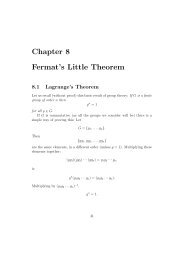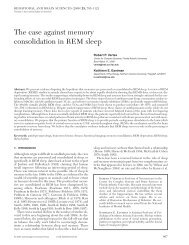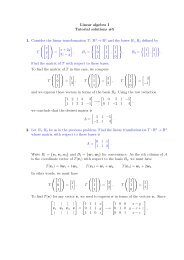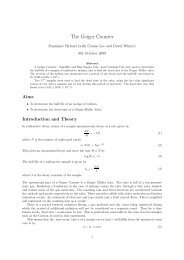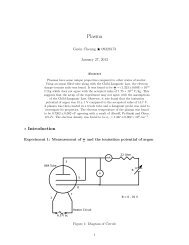Parallel Computing
Parallel Computing
Parallel Computing
You also want an ePaper? Increase the reach of your titles
YUMPU automatically turns print PDFs into web optimized ePapers that Google loves.
<strong>Parallel</strong> <strong>Computing</strong><br />
Used when jobs are to big for a single<br />
processor. A simple analysis can be done<br />
with Amdahl’s Law.<br />
S = tseq<br />
tpar<br />
= (1 − Fp)tseq + Fptseq<br />
(1 − Fp)tseq + Fptseq<br />
Np<br />
For a maximum speed up of<br />
1<br />
(1−Fp)+ Fp<br />
Np<br />
where Fp = amount of the job that is<br />
(perfectly) parallelisable and Np = number<br />
of processors.<br />
20<br />
18<br />
16<br />
14<br />
12<br />
10<br />
8<br />
6<br />
4<br />
2<br />
0<br />
Speedup for 95% parallelisable job<br />
2 4 6 8 10 12 14 16 18 20<br />
1<br />
proc<br />
speedup<br />
,
Good news:<br />
• Bigger problems often have large Fp.<br />
• A lot of time spent in loops, which are<br />
often good candidates for<br />
parallelisation.<br />
Bad news:<br />
• Not always perfectly parallelisable.<br />
• Overhead can be high (communication<br />
& synchronisation).<br />
• <strong>Parallel</strong>ising can be hard work for the<br />
programmer.<br />
2
Types of <strong>Parallel</strong> Computer<br />
Various attempts have been made to<br />
classify parallel computers:<br />
• SIMD, MIMD, MISD computers.<br />
• Vector computers.<br />
• Shared or Distributed memory.<br />
• network topology used.<br />
3
Single Instruction, Single<br />
Data<br />
Instruction Stream<br />
Processor<br />
Data In Data Out<br />
Conventional computer.<br />
Single Instruction, Multiple<br />
Data<br />
Instruction Stream<br />
Data In Data Out<br />
Eg. CM-2 (65535 proc) or MasPar<br />
(16384).<br />
4
Multiple Instruction, Single<br />
Data In<br />
Instruction Streams<br />
Data<br />
Uncommon, used in image/signal<br />
processing.<br />
Multiple Instruction,<br />
Multiple Data<br />
Instruction Streams<br />
Data In Data Out<br />
Data Out<br />
Eg. Network of Workstations, IBM SP,<br />
CM-5.<br />
5
Vector Processor<br />
Type of SIMD machine? Based on idea<br />
that operations like: w = u + av and<br />
a = u · v are common.<br />
Vector co-processor with vector registers<br />
(64-128 doubles per reg). Performs<br />
operation on whole vector register in one<br />
instruction.<br />
Compiler replaces loops with vector ops.<br />
for( i = 0 ; i < n ; i++ )<br />
w[i] = i[i] + a ∗ v[i];<br />
Vector computers need to get data quickly<br />
and will have to use interleaving or other<br />
techniques to get data fast enough.<br />
Eg. Cray T90, NEC SX-4, Fujitsu<br />
VPP700, Hatachi S3800.<br />
6
Shared/Distributed Memory<br />
Are changes to data visable implicitly?<br />
Shared Mem:<br />
CPU<br />
Mem<br />
CPU CPU<br />
Mem<br />
Interconnect<br />
Easier to program, but CPU caches must be<br />
keep syncronised.<br />
Distributed Mem:<br />
CPU CPU CPU<br />
Mem Mem<br />
Interconnect<br />
Mem<br />
Data must be passed explicitly.<br />
7
SMP<br />
A Symetric Multi-Processor computer has<br />
several CPUs connected to a single<br />
memory. Each CPU may have its own<br />
cache. All CPUs are equal in the eyes of<br />
the kernel.<br />
Competition on the bus prevents huge<br />
numbers of processors but 64 processor<br />
machines are not uncommon (Sun & SGI).<br />
Compilers are available which can<br />
automatically parallelise code for SMP<br />
machines. Threads also work well on SMP<br />
machines.<br />
Locking of data is an important issue for<br />
the kernel and application on SMP<br />
machines.<br />
8
NOW<br />
A network of workstations is a Distributed<br />
Memory system.<br />
IBM SP A collection of IBM 1 or n<br />
processor workstations connected by a<br />
special high speed switch.<br />
Linux Beowulf Patches for Linux to make<br />
a cluster of PCs seem more like one<br />
machine. Uses ethernet as<br />
interconnect.<br />
distributed.net Many different computers<br />
around the world using the internet as<br />
interconnect.<br />
NOW is popular and (possibly) cheap high<br />
power computer system. Programming is<br />
more complicated than SMP.<br />
9
Interconnect<br />
Bus One pair can communicate at a time.<br />
Complexity independant of Np,<br />
between node bandwidth 1/Np.<br />
Cross-bar All processors linked with<br />
matrix of switches. Requires O(p 2 )<br />
switches, between node bandwidth of<br />
1/Np.<br />
10
Ring Each processor connected to 2<br />
nearest neighbours. Requires p/2 hops<br />
at worst.<br />
2-d mesh Each processor connected to 4<br />
nieghbours. Requires about (p)<br />
hops at worst.<br />
11
2-d torus Each processor connected to 4<br />
nieghbours. Requires about (p)/2<br />
hops at worst.<br />
3-d mesh/tours Each processor connected<br />
to 4 nieghbours. Requires about 3 (p)<br />
hops.<br />
12
Cube/Hypercube 2 d processors each with<br />
d connections. Gets complicated<br />
quickly.<br />
Other Some systems use networks of<br />
switches (Omega Netowrk - IBM SP)<br />
or irregular netowrks (distributed.net,<br />
NOW). Others again use combinations<br />
of the above (‘hyper-cross bar’, 3d<br />
mesh with crossbar along edges).<br />
13
Assignment<br />
Various libraries have been developed<br />
which make programming parallel<br />
computers easier. PVM and MPI are two<br />
such libraries. PVM (<strong>Parallel</strong> Virtual<br />
Machine) grew and MPI (Message Passing<br />
Interface) was designed. We will be using<br />
MPI.<br />
Write a program calculates n<br />
i=1<br />
1<br />
n in<br />
parallel. It should take n as an argument on<br />
the command line, eg: recipsum<br />
100000. Try summing smallest to largest<br />
and see if you get a different answer.<br />
MPI Docs:<br />
http://www.netlib.org/mpi<br />
14





